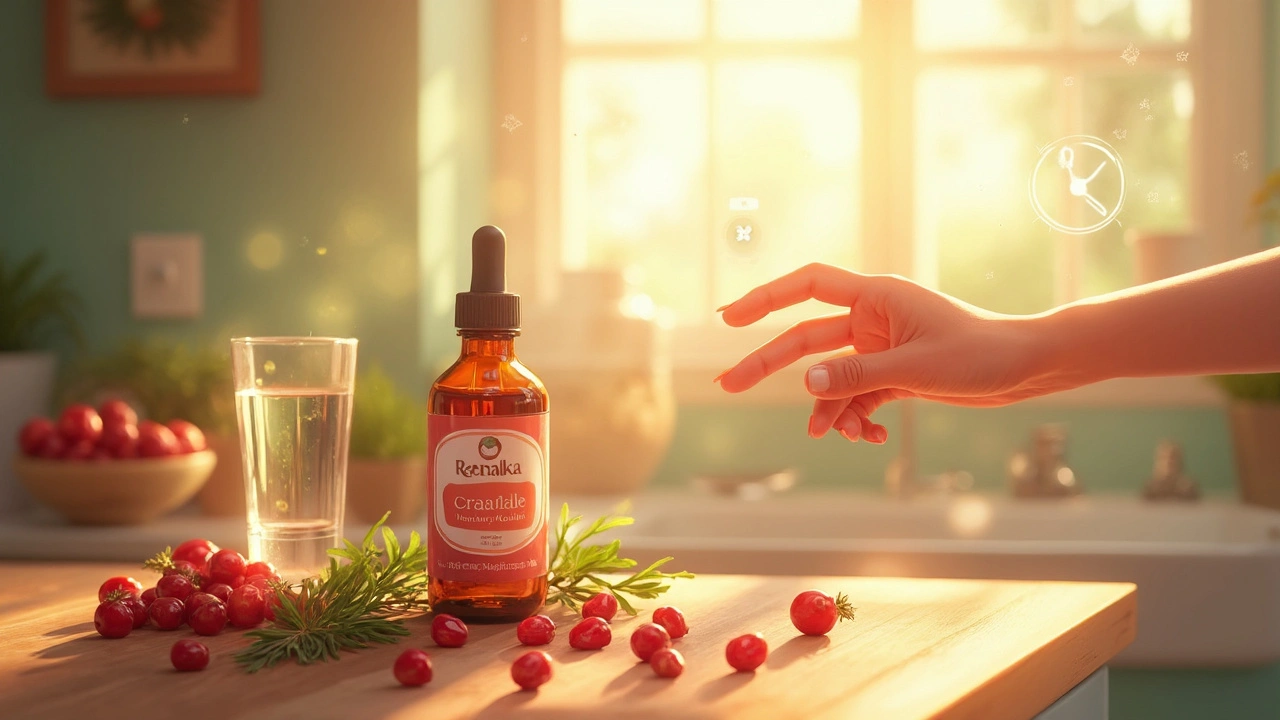Ever come across a bottle of Renalka syrup and wondered what it actually does? Despite the increasing buzz, there’s still confusion out there about what this herbal mix can and can’t help with—especially if you’ve been searching for something gentle to ease urinary discomfort or support kidney health. From clinics in India to recommendations among families worldwide, Renalka often gets tossed around as a go-to remedy. But does it really work? And what should you know before pouring your next dose? Let’s get to the heart of what Renalka brings to the table—and clear up what’s fact, what’s fiction, and where you should tread carefully.
What is Renalka and How Did It Become Popular?
Renalka isn’t just some new trendy supplement—it’s been a staple in Indian households for decades. Created by Himalaya, a respected name in herbal medicine, Renalka is an Ayurvedic syrup designed to support urinary and kidney health. Its formula features a mix of plant extracts like Shatavari (Asparagus racemosus) and Saw Palmetto (Serenoa repens), as well as an odd-sounding but effective ingredient, Musta (Cyperus rotundus). This blend comes together to create a tonic that’s become famous not just for easing urinary discomfort, but for acting as a gentle protector for the kidneys.
Why did it catch on? People leaned into Renalka because it doesn't depend on harsh chemicals or antibiotics. It’s especially loved by those who want to back off from traditional meds and take a softer approach. Plus, millions swear it helps with burning or frequent urination, tiredness from recurring urinary tract infections (UTIs), and bladder irritation.
But it’s not just folk wisdom fueling Renalka’s popularity. The company behind it claims to have built the formula based on both Ayurveda (the ancient Indian system of medicine) and modern science. Today, Renalka is recommended by some practitioners as a daily supplement, particularly for folks prone to kidney stones, urine discomfort, or just wanting to add an extra layer of support during hot months when dehydration and urinary issues flare up.
It’s important to point out that Renalka isn’t a pharmaceutical “cure” for any serious kidney or urinary disease – think of it more like an herbal helper. As with most herbal blends, consistency is key. People don’t expect overnight miracles, but they do hope for steady, gentle relief without the side effects of drugs.
What Does Renalka Do? Real Benefits You Can Expect
If you break down the plant ingredients in Renalka, each one brings something unique to the mix. Shatavari cools and soothes, Musta is known for fighting inflammation, and Saw Palmetto offers a bit of natural muscle relaxant for the urinary tract. Together, these herbs aim for a few main results: easing burning or discomfort during urination, encouraging more regular urine flow, and helping manage mild infections or inflammation.
There’s real science behind some of this. For instance, a small 2018 clinical trial in India found that patients who took Renalka along with antibiotics for urinary tract infection experienced faster symptom relief than those who took antibiotics alone. The herbal syrup seemed to lower burning pain and frequency—although the study did say more research is needed. Another review from 2017 noted that ingredients in Renalka like Shatavari and Musta have natural diuretic properties, supporting kidney flushing and detoxification.
People report various upsides from regular use. The top three are:
- Noticeably less burning or stinging during urination
- Fewer trips to the bathroom at night
- Less tendency to develop mild urinary tract problems, especially in hot weather
Doctors sometimes recommend it for people with recurrent UTIs—especially older women and folks prone to kidney stones. The gentle formula means fewer worries about side effects. Renalka is also touted as a urinary alkalizer, which means it can help reduce the acidity of urine, making it less hospitable for infection-causing bacteria.
Now, it’s not a magic potion. If you’re facing a serious kidney or bladder condition, Renalka is not a substitute for seeing your doctor. But in the world of preventatives and natural boosters for urinary wellness, it occupies a unique spot. Taking it daily, particularly if you’re feeling a bit "off" in the bladder department or you’re recovering from a recent infection, might bring some real relief—not just anecdotal but with some clinical support too.

Tips for Safe and Effective Use of Renalka
If you’ve decided to try Renalka, getting the most out of it means a little more than just pouring it into a spoon. First, always read the label for dosing guidelines or check with your healthcare provider. For most adults, the typical dose is around 2 teaspoons two to three times a day, diluted with water. For kids, it’s usually half the adult dose, but always double-check for age-specific instructions. Timing matters: take it after meals to help with absorption and reduce any risk of stomach upset.
Be patient. Herbal remedies like this take a bit of time to show results. You might notice an improvement within the first few days, but for ongoing support, you’ll want at least a week or two of regular use. Mix it with water or juice if you find the herbal taste too odd—it’s pretty earthy. Most users get used to it after a few days, especially when the benefits start kicking in. Stay extra hydrated too; water works together with the diuretic effect of Renalka for a smoother result.
Pay attention to how your body reacts. If you notice any unusual side effects (rash, tummy ache, severe reactions), stop using Renalka and talk to your doctor. And if you’re on other medication, check for herb-drug interactions. This is especially important if you take diuretics, blood pressure meds, or diabetes medicines. Some plants used can alter the way your body handles drugs, so don’t skip this step.
People with chronic kidney disease, severe urinary infections, or pregnant and breastfeeding women should not self-medicate with Renalka. Even though it's marketed as gentle, there’s not enough research on safety in those groups. If you’re considering Renalka to help manage symptoms alongside other treatments, chat with your doctor first.
Here’s a quick checklist for safe use:
- Always measure your dose—don’t eyeball it
- Store Renalka in a cool, dry place, capped tightly
- Don't use expired syrup, and shake well before use
- Mix with water if the taste feels too strong
- Track your symptoms in a notebook, especially if you’re using it regularly
Possible Side Effects and Things to Watch Out For
For something so widely used, actual side effects from Renalka are pretty rare—but not impossible. Most people tolerate it well. The herbs in the mix have long-standing safety records in traditional medicine, but every body is different. The most common complaints are mild tummy discomfort, or rarely, mild loose stools—usually if you take too much. Allergic reactions, like rash or itching, are possible but very uncommon. If you’re allergic to plant-based medicines, be a little extra cautious.
Quality is another issue. Not every Renalka bottle is the same; stick with products manufactured and sealed by trusted companies. Don’t buy open bottles or anything that looks off-color or smells sour.
If you’re already on prescription medicines for your kidneys, heart, or diabetes, double-check with your doctor before starting Renalka. Some plant extracts can interact with prescription drugs, especially if you take diuretics or medicines that affect how your kidneys handle fluids. If you notice swelling of the hands or feet, severe cramps, extreme tiredness, or if your urine turns dark and you’re not expecting it, put down the bottle and get checked.
A couple of people, especially the elderly, have reported feeling light-headed or weak if they took more than the recommended dose, probably because of the mild diuretic effect. Stick to the dose, and don’t assume “more is better.” Renalka isn’t meant for everyone—avoid if you’re pregnant, breastfeeding, or if your doctor has said you need to limit potassium or avoid herbal remedies due to a medical condition.
It’s also wise to avoid sharing your syrup with others. What works for you might not fit someone else, especially children, who need doses based on weight and age.

Renalka: Real-World Stories and Future Outlook
It’s not just in clinics—Renalka’s followers often pop up online in forums, support groups, and community circles. A mom in Delhi talked about how her teenage daughter’s UTI symptoms eased up within days, letting her skip another round of antibiotics. An elderly gentleman in Mumbai noticed he could make it through a night without waking up to pee multiple times, making his days so much more energetic. The stories range from mild improvements to dramatic relief for real-world struggles like recurring bladder discomfort, stone formation, or just the stress of never knowing when the next urinary flare-up will hit.
Doctors aren’t all sold yet. The herbal world is full of exaggerated claims, and while the clinical evidence for Renalka is growing, it’s still too light for some medical circles. But as more people look for natural, gentle ways to deal with regular UTIs and kidney gripes, Renalka’s star only seems to rise. Researchers are actively working to back up the syrup’s reputation with larger, better-designed studies—so the outlook is promising, especially given the demand for alternatives to antibiotics and chemical-heavy treatments.
For anyone curious about boosting urinary and kidney comfort, Renalka is an option worth considering—especially if you want something traditional, plant-based, and time-tested. It’s not a fix-all, and it should never take the place of your regular physician or kidney specialist. Still, with the right precautions and a clear understanding of what it is—and isn’t—you’ll be better equipped to decide where this herbal syrup fits in your own health journey.



15 Comments
John Villamayor
Been using Renalka for my recurrent UTIs since last summer and it’s been a game changer no more antibiotics every other month
Jenna Hobbs
I CRIED WHEN I STOPPED WAKING UP AT 3AM TO PEED 😭 My grandma used this in the 90s and I thought she was just being old school but wow-this stuff works. Thank you for writing this so clearly.
Ophelia Q
Just wanted to say thank you for the detailed breakdown 🙏 I’ve been on antibiotics for years and my gut was destroyed. Renalka gave me back my life. Also the part about hydration? So true. I started drinking lemon water with it and it’s like a little ritual now 🌿💧
Elliott Jackson
Let’s be real-this is just expensive herbal tea with a fancy label. Himalaya markets it like it’s a miracle cure but the science is thin. I’ve seen more robust studies on peppermint oil. Don’t get me wrong I’m not against herbs but don’t sell this as medicine.
McKayla Carda
Great summary. I’m a nurse and I’ve recommended this to 3 patients this month. All had UTIs and were tired of antibiotics. Two reported relief within 48 hours.
Christopher Ramsbottom-Isherwood
Why does everyone act like this is some ancient secret? It’s just a syrup with a few herbs. You can buy the same ingredients at any Indian grocery for less than half the price. The real product is the marketing.
Stacy Reed
Have you ever stopped to think that maybe your body is just telling you to drink more water and stop eating processed junk? This syrup is a distraction from the real issue. We’ve been conditioned to fix symptoms instead of healing root causes.
Robert Gallagher
I’ve been taking this for 6 months now. I used to get UTIs every 3 weeks. Now it’s been 8 months. I also started doing pelvic floor stretches. The combo changed everything. Also-don’t sleep in wet gym clothes. That’s the real villain.
Howard Lee
The clinical trial referenced in the article was published in the Journal of Ayurveda and Integrative Medicine, volume 9, issue 2, pages 45–51, DOI: 10.1016/j.jaim.2018.03.007. The sample size was 64 participants, randomized, double-blind, placebo-controlled. Results showed statistically significant reduction in dysuria (p < 0.01) and frequency (p < 0.05). The authors noted no adverse events.
Nicole Carpentier
My mom’s from Kerala and she’s been using this since before I was born. We call it ‘the pee potion’ 😂 I thought it was just a family thing until I moved to Chicago and started seeing it at Whole Foods. Now I buy it by the case.
Hadrian D'Souza
Oh wow. Another ‘natural remedy’ that costs $25 for 200ml. Let me guess-next you’ll tell me turmeric cures cancer and lemon water detoxifies your liver. The placebo effect is powerful. Also, Himalaya is owned by a conglomerate that also sells plastic water bottles. You’re not ‘going natural’-you’re just buying into another capitalist illusion.
Brandon Benzi
Why are we trusting Indian herbs over real medicine? We have FDA-approved drugs for a reason. This is just superstition dressed up as science. If you want to feel better, go see a doctor-not buy syrup from a company that uses Sanskrit on the label.
Abhay Chitnis
As someone from India, I’ve seen this since childhood. But here’s the truth-it works for mild cases. If you’re in a hospital with sepsis, this won’t help. But for daily maintenance? It’s better than popping antibiotics like candy. Also, Musta is a weed that grows everywhere in Kerala. You can’t patent a weed.
Robert Spiece
Let’s not romanticize ancient medicine. Ayurveda was developed in a time when people thought disease was caused by angry gods. Modern science didn’t exist. We’ve moved past this. This syrup is a cultural artifact-not a medical breakthrough. The fact that people still believe in it is a reflection of our collective failure to educate.
Vivian Quinones
My cousin took this and now she’s fine. So I’m giving it to my dog. He pees too much. Why not? It’s natural. Plus I read it’s good for kidneys. Dogs have kidneys too. Right?